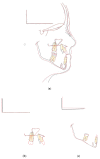Intercepting of Class III Malocclusion with a Novel Mechanism Built on the Orthopaedic Appliance: A Case Report
- PMID: 35740723
- PMCID: PMC9222061
- DOI: 10.3390/children9060784
Intercepting of Class III Malocclusion with a Novel Mechanism Built on the Orthopaedic Appliance: A Case Report
Abstract
Aim: The following case report aims to show a novel orthopaedic appliance to reduce the side effects of the orthopaedic Class III treatment through the use of two acrylic splints combined with a PowerScope device.
Materials and methods: This case report describes the treatment of a 6-year-old patient with a skeletal Class III relationship with a maxillary deficiency and a severe hyperdivergency. The patient underwent a sagittal orthopaedic treatment with a PowerScope device for 12 months. The retention period lasted 4 months.
Results: The response of the craniofacial complex to the active orthopaedic treatment of the Class III malocclusion with the PowerScope™ device splints consisted of significant changes in maxillary growth and position. Both angular and linear sagittal measurements of the maxilla showed improvements during active treatment, respectively, of 0.6° and 1.2 mm (SNA from 75.8° to 76.4°; maxillary length from 38.8 mm to 40 mm). These effects allowed for a highly significant improvement in the maxillomandibular skeletal relationships. ANB improved by 1.6° and Wits appraisal by 4 mm. Using this appliance in a hyperdivergent patient, we obtained a vertical control of the mandible with a SN/Go-Gn stable value at 40° and a significant improvement of the ANS-PNS/GoGn angle from 30° to 28°.
Conclusion: The Class III orthopaedic treatment with the PowerScope™ telescopic and NiTi spring device mounted on the upper and lower resin splints in a Class III correction offered good vertical control during the early orthopaedic treatment by improving the skeletal discrepancy and controlling the hyperdivergency, which is one of the most difficult factors to control in Class III malocclusions.
Keywords: Class III malocclusion; functional appliance; orthopaedic treatment; paediatric dentistry.
Conflict of interest statement
The authors declare no conflict of interest.
Figures









References
Publication types
LinkOut - more resources
Full Text Sources
Research Materials

